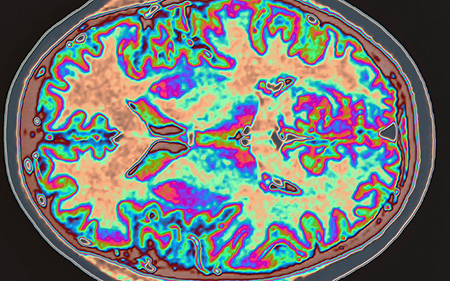Current Screening Methods Miss Worrisome Number of Persons with Mild Cognitive Impairment
“False-negatives” mean persons at greater risk for Alzheimer’s disease may not get timely care
Published Date
By:
- Scott LaFee
Share This:
Article Content

Colorized magnetic resonance image of human brain.
Mild cognitive impairment (MCI) is a slight but noticeable and measurable decline in cognitive abilities, such as remembering names or a list of items. While changes may not be severe enough to disrupt daily life, a clinical diagnosis of MCI indicates an increased risk of eventually developing Alzheimer’s disease or another type of dementia.
In a paper published in the current Journal of Alzheimer’s Disease, researchers at University of California San Diego School of Medicine and Veterans Affairs San Diego Healthcare System say existing screening tools for MCI result in a false-negative error rate of more than 7 percent. These persons are misclassified as not having MCI based on standard screening instruments, but actually do have MCI when more extensive testing is conducted.
“There are consequences to misdiagnosis,” said first author Emily C. Edmonds, PhD, a postdoctoral fellow of neuropsychology in the Department of Psychiatry at UC San Diego School of Medicine. “At the individual level, people incorrectly identified as cognitively normal might not receive appropriate medical advice or treatment. This could include preventive measures, such as diet or lifestyle changes to maintain cognitive function, or a referral to other health care providers.”
Beyond that, Edmonds said diagnostic errors can also negatively impact research studies of MCI and early Alzheimer’s disease. “If research participants are misclassified when they enroll in a study, this can weaken the study’s results, which makes it even more difficult to find and develop effective treatments or therapies.”
Current diagnostic criteria for MCI, which are broadly used, rely upon subjective memory complaints by the person being screened, a single test score indicating impaired memory, and clinical judgment. Study authors say this approach can produce significant errors in diagnosis. They noted that their past research has also shown a high rate of “false-positives,” which are errors in the opposite direction. “False-positives” are when people are classified as having MCI based on standard diagnostic criteria, but they do not actually have it upon further testing.
“We have previously found that as many as one-third of MCI cases diagnosed with the standard method are false-positive errors,” said Edmonds. “This, coupled with our recent finding of a 7 percent false-negative error rate, is concerning and tells us that the diagnostic criteria could be improved.”
Researchers examined data from 520 individuals participating in the Alzheimer’s Disease Neuroimaging Initiative, a nationwide, multi-institution study of MCI and Alzheimer’s Disease. All of the participants, almost evenly split by gender with a mean age of 74.3 years, underwent standard MCI screening and a more in-depth diagnostic process that involved additional memory and learning tests.
Thirty-seven individuals (7.1 percent) were identified as cognitively normal based on standard criteria, but qualified for MCI diagnosis using the more comprehensive testing. In addition to mildly impaired cognitive performance, they showed tell-tale biomarkers in their cerebrospinal fluid indicating they are at-risk for future dementia. The remaining participants tested normal using both methods – a true-negative rate of 92.9 percent.
The findings, concluded the authors, show that the use of rigorous diagnostic criteria that include formal neuropsychological tests and less reliance on standard screening methods for MCI can improve clinical research studies and better predict who is likely to progress from MCI to dementia.
Co-authors include Lisa Delano-Wood, Amy J. Jak, Douglas R. Galasko and senior author Mark W. Bondi, all at UC San Diego and Veterans Affairs San Diego Healthcare System; and David P. Salmon, UC San Diego.
Funding for this research came, in part, from the National Institutes of Health (RO1 AG049810, K24 AG026431, P50 AG05131), with data collection and sharing support via the Alzheimer’s Disease Neuroimaging Initiative.
Share This:
You May Also Like
Stay in the Know
Keep up with all the latest from UC San Diego. Subscribe to the newsletter today.



